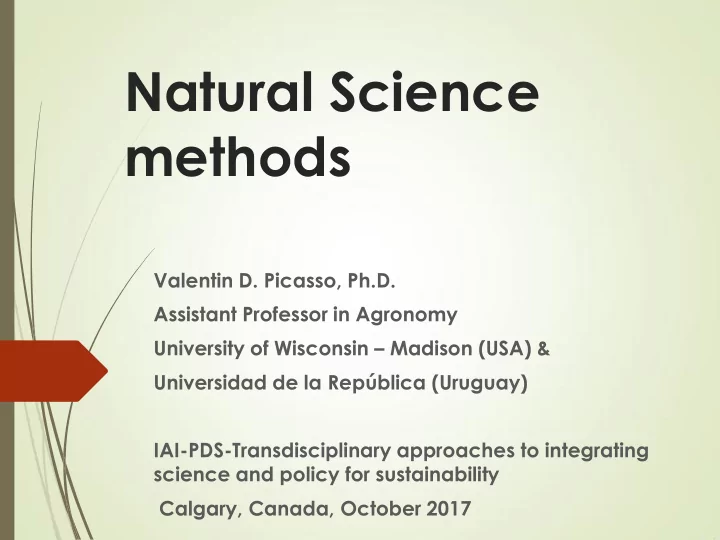

Natural Science methods Valentin D. Picasso, Ph.D. Assistant Professor in Agronomy University of Wisconsin – Madison (USA) & Universidad de la República (Uruguay) IAI-PDS-Transdisciplinary approaches to integrating science and policy for sustainability Calgary, Canada, October 2017
Transdisciplinary approaches communication understanding disciplinary methods, assumptions, paradigms
“Our” approach Problem or Question Hypothesis or possible answer Design an experiment Collect data, measure variables Analyze data (statistics) Reject hypothesis (or not) Generalization Modeling
Example of experiment What is the effect of livestock grazing management on animal productivity? < Hypotheses: • Rotational grazing produces more forage than continuous grazing • Rotational grazing produces more meat than continuous grazing
Experimental design Treatments (independent variable) Response (dependent variable) Experimental unit (plot) Error (not controlled variables)
Example of experiment What is the effect of livestock grazing management on animal productivity? Treatments: continuous vs rotational grazing Response: animal productivity Experimental unit: paddock
Principle 1: Replication
Principle 2: Randomization
Principle 3: Local control
Principles of experimental design By Sir. R. A. Fisher: Replication (measure error) Randomization (independent errors) Local control of variation/blocking (reduce error) 1935
Experimental design Block 1 Plot 1 Plot 2 2 treatments • Block 2 Plot 3 Plot 4 10 plots • Block 3 Plot 5 Plot 6 5 blocks based on • soils and slope of Plot 7 Plot 8 Block 4 field Plot 9 Plot 10 Block 5 Treatments • randomly assigned to plots in each block (Completely randomized block design)
Collect data Plot Block Treatment Forage kg/ha Meat kg/ha 1 1 Continuous 1200 50 2 1 Rotational 2000 100 3 2 Rotational 1800 70 4 2 Continuous 1300 60 5 3 Rotational 2200 90 6 3 Continuous 1400 80 7 4 Continuous 1000 60 8 4 Rotational 2100 80 9 5 Rotational 1900 60 10 5 Continuous 1100 70
Analyze data (Statistics) Forage (kg/ha) Meat (kg/ha) Continuous Rotational Continuous Rotational Mean 1200 2000 64 80 Minimum 1000 1800 50 60 Maximum 1400 2200 80 100 St. Deviation 158 158 11 16 Are there differences between treatments?
Statistical Analysis ANOVA: Analysis of Variance How much is the variability due to the treatments? How much is the variability due to error? Is the variability due to treatments large enough to be considered significant?
2500 Forage productivity (kg/ha) 2000 1500 1000 500 Continuous Rotational grazing grazing 0 Treatment
90 80 Meat productivity (kg/ha) 70 60 50 40 30 20 Continuous Rotational grazing grazing 10 0 Treatment
2500 Forage productivity (kg/ha) 2000 1500 1000 500 Continuous Rotational grazing grazing 0 Treatment
120 100 Meat productivity (kg/ha) 80 60 40 20 Continuous Rotational grazing grazing 0 Treatment
Analyze data (Statistics) Forage (kg/ha) Animal (kg/ha) Continuous Rotational Continuous Rotational Mean 1200 2000 64 80 St. Deviation b a A A Hypotheses: • Rotational grazing produces more forage than continuous grazing – YES • Rotational grazing produces more meat than continuous grazing – NO
Analysis: are two variables associated? Correlation: linear association between 2 variables Regression: equation that describes the change in one variable due to another one Linear equation vs other models
120 Meat productivity (kg/ha) 100 80 60 40 y = 0.02x + 35 R² = 0.43 20 0 500 1000 1500 2000 2500 Forage productivity (kg/ha)
Epistemology Empiricism Positivism Cause-effect relationships Reductionist / Analytical: breaking reality in pieces Repeatability (always happens the same) Objectivity (anyone gets same results) Hypothesis: a guide meant to be rejected Paradigms (Kuhn) Modeling (integration) Emergent properties? Interactions?
Thank you! Valentín Picasso picassorisso@wisc.edu
GPS Project: Grasslands + People + Sustainability - Funding: Roundtable for Sustainable Calgary - Grasslands are cool, threatened, forgotten, etc. - People in Calgary care about sustainability, etc. - Livestock management may be a key driver for sustainability
GPS Project: Grasslands + People + Sustainability - Goal: To improve sustainability of livestock systems in grasslands, through scientific knowledge and policy recommendations - Our research question is: What makes livestock systems sustainable in Calgary? - Transdisciplinary team: - Social scientists, - Natural scientists, - Local citizens and - policy makers
Interviews – Social Science 6 general public 2 environmentalists 2 policy makers 2 ranchers 5 groups of 4 participants One pair per group interviews general public, the other pair interviews stakeholders Each pair is doing 6 interviews of 10 minutes Each group makes 12 interviews
Agronomic experiment - Natural Science University of Calgary Bear Field Research Station Compare 2 livestock grazing management strategies: Current system: continuous grazing Alternative system: rotational grazing
Variables Animal productivity (kg/ha) Forage productivity (kg/ha) Forage height (cm) Plant species richness Soil cover (%) Weed cover (%) Soil organic matter (%) Each team of 4 people will measure each variable in 2 plots
Experimental site
Experimental design Block 1 Plot 1 Plot 2 2 treatments • Block 2 Plot 3 Plot 4 10 plots • Block 3 Plot 5 Plot 6 5 blocks based on • soils and slope of Plot 7 Plot 8 Block 4 field Plot 9 Plot 10 Block 5 Treatments • randomly assigned to plots in each block (Completely randomized block design)
Recommend
More recommend